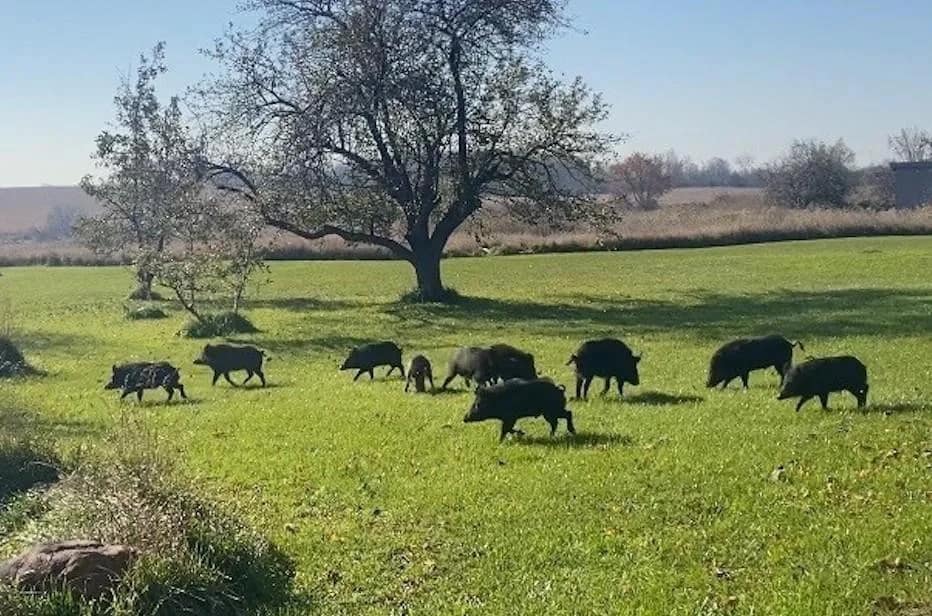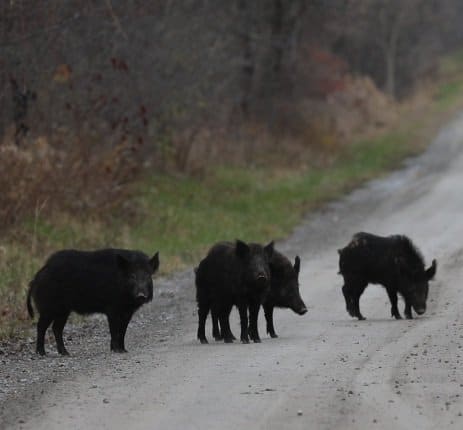Marshmallow fluff the secret in Pickering capture of escaped Eurasian Wild Boars
Published December 8, 2021 at 11:54 am

The month-long tale of the wild boars on the loose in north Pickering reached its final chapter this week when ministry officials were able to trap the last of 14 escaped hogs with the help of a magic bait: fluffernutter on a stick.
The Eurasian Wild Boars, which would likely wreak environmental havoc if allowed to breed, had been spotted numerous times in the Brougham and Claremont area throughout November, prompting officers from the Ministry of Northern Development, Mines, Natural Resources and Forestry to arrive with traps, trail cameras and a lot of ideas on how to catch the pigs.
Mary Delaney, a noted environmental activist in Pickering and the Chair of Land Over Landings, got to see the wild boars up close as they dug up her back yard in search of grubs and she got to see first-hand the efforts of the ministry officers in luring the pigs into the traps.
“Fascinating to be close to the process and learn so much as it unfolded, much of it all brand new. There was no protocol for this,” Delaney said on social media, adding that the ministry team of Ryan and his partner Kat were “amazing.”
(*Ryan and Kat have requested their last names not be used*)
Delaney said the ‘Jaws’ moment for her (“We’re going to need a bigger boat”) was when she saw all 14 together, which is when the baiting began.
Stale doughnuts were tried, along with corn (after experts in Texas said the pigs “love corn”), followed by fermented soybeans, before it was pointed out there were “9,000 acres” of corn, soybeans, apples, roots, tubers and grubs and other wild boar delicacies already available for the animals.
“And then they came back,” remembered Delaney. “Exactly one week later, four of them digging up our lawns, and under our feeder, right by our kitchen window. My husband chased one off with a pitchfork, afraid the whole time that the other ten were behind him. Clearly, these were unafraid, recently domesticated boars.”

Photo Colin Williamson
The ministry team then set up a trap right behind her barn, along with a wildlife cam and bait — jujubes, gummies, sardines and bacon fat. “All the good stuff,” Delaney said. But it didn’t do the trick.
“Nothing. Not one animal. Not a raccoon, not a coyote.”
The ‘sounder’ of boars were eventually located, thanks to a friend’s heat-seeking drone, and the baiting began again, but after a week the team was running out of ideas.
“One day when we were chatting and Ryan said he was off to get marshmallow fluff. ‘Good idea,’ I said. ‘I always use peanut butter to bait ‘coon traps. It’s sticky. They can’t grab it and run.’ And that is how the magical fluffernutter on a stick was born. On a stick to wave the scent in the breeze. He also made Shrek-sized batches of oatmeal, molasses and date syrup.”
Clearly, the boars were so done with corn and beans and apples and wanted dessert, she explained. And once they were enjoying the bait regularly a giant trap – 20 feet across -was set up.
“The goal was to get them all at once. One of their many survival skills is that they scatter if frightened. They are extremely smart, so if they only got some and alarmed them, the others would disperse and become more wary. “
On November 30 eleven of the 14 were captured. On December 6 – Delaney got the text at 3:33 p.m., to be precise – the last three were lured into the trap.
The boars were humanely euthanized, according to ministry spokesperson Morgan Kerekes, who said the animals will be sent for necropsy and research. “Through this research, we will learn about the condition of wild pigs in Ontario, potential diseases and pathogens and outcomes will inform future management.”
Kerekes added that wild pigs are considered one of the most damaging invasive species on the continent and have been called an ‘ecological train wreck’ due to trampling, wallowing and rooting in sensitive habitats, and the significant damage they can cause to farmlands and stored crops.
“Wild pigs can also impact native plants and animals directly through predation and indirectly through competition for food and destruction of habitat. They can spread disease to native wildlife and livestock, such as African Swine Fever. Our goal is to reduce the disease risk these animals pose to Ontario’s domestic herd and the extensive damage they can do to agricultural crops.”
Delaney pointed out that the wild boars, while derived from wild stock, were escaped domestic animals destined for the slaughterhouse.
“These beasts had one helluva last month of living up to their name. They were wild!”
For Delaney, she is just glad the experience – while exciting – has been put to bed. “So relieved it’s over. Had our best sleep in weeks.”
insauga's Editorial Standards and Policies advertising






